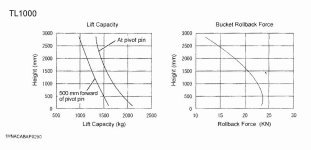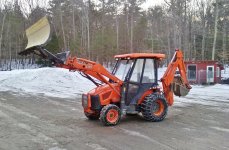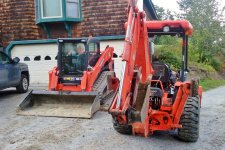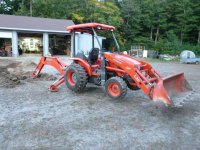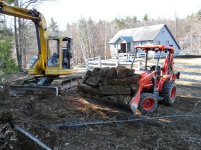rScotty
Super Member
- Joined
- Apr 21, 2001
- Messages
- 9,663
- Location
- Rural mountains - Colorado
- Tractor
- Kubota M59, JD530, JD310SG. Restoring Yanmar YM165D
This unit has the padded feet, like for paved surfaces. So it's not really "biting" into the turf. It's just sliding and making a mess. I've got all the wheels off the ground and the bucket is preventing it from pushing the tractor, but the loader bucket doesn't do anything to prevent it from pulling the tractor.
As we say around here, "That must have been quite the rodeo.....!" I'm sorry to have missed it. The normal way to deal with padded feet on dirt is to reverse the foot pads. Most are reversible with steel on the other side.....I don't know about the L47. But there just isn't much you can do with frozen ground; I wouldn't even try it on the big JD310. And that is a true construction machine - over 20,000 lbs set up as it is with foot pads that take real muscle to reverse. The 310's pads are huge cast things that must weigh close to 100 lbs each. Yet it is helpless as a kitten on frozen ground.
Normally we guys who like to play in the dirt wait until thaw when we can deal with hard-packed ground by first tearing it up with plow or scarafier of some sort...A FEL bucket by itself won't do much to hard-packed or even medium packed ground. Even a bulldozer prefers to have the ground torn up first. And that's for normal unfrozen dirt. None of them will do squat to frozen ground. Pretty much nothing will work frozen ground.
To tear up unfrozen ground for the FEL bucket to transport, I use the nifty SSQA to swap to a rock bucket which is pretty good at tearing up the ground. After the ground is loosened, any FEL loader tractor's bucket can easily load it up, transport it, and level it up by back dragging. The L45 is more than enough machine to do that job - scarifying and then moving and leveling. It something that all compact tractors do well.
The inching is neat, but it didn't work going up any sort of incline. And disengaging the front parking brake from the reversed seat is impossible. And yeah, the rear parking brake not being engaged while you swivel the seat seems unsafe. I was on a hill and started to roll while I was spinning the seat around. I dropped the legs and stopped the roll, but I should have been able to leave the parking brake on. Strange design.
The inching function is handy, but using it takes some practice. Kubota's instructions don't make it clear that the incher works like a hand-operated extension of the foot pedal. That means you need to know what gear you are in and have the auto-throttle on. To use it better, shift the range lever into low or turtle-medium before rotating around to the backhoe position. Be prepared that you'll have to really lean on the incher lever against a strong spring to get it to rev up and move....then it will surprise you.
Yes, the kindest thing I can say about Kubotas TLB parking brake is it is a poorly thought out. My guess is a first try by a novice mechanical system designer. Compare it with commercial TLBs which use an electrically switched mechanical solenoid to activate the parking brakes which then remain locked any time the engine is not running. You cannot start a commercial tractor without cycling the parking brake, and if you try to put it in gear with the parking brake still engaged a loud alarm goes off. IMHO, that type of system is minimal for good practice when the brake pads are internal and especially when they share fluid with the transmission.
The parking brake is a real weakness with Kubota - and with lots of other Ag and CUT tractor brands too.
For the small homeowner type stuff, like digging out rocks in the yard, moving compost, tending the gravel drive, dragging fallen trees, etc., I think this machine is fine. When it comes to re-grading the yard to drain better, I doubt even the M59 is going to be enough. I either need to get some pros with heavy equipment back here or come up with an active drain system that pumps uphill. The ground was frozen, so I'm sure that's not helping, but just sitting out there looking at how many cubic yards of shale and dirt will need to be moved and how many hundreds of feet I'll need to move them... It's either an all-summer job for a small TLB and this homeowner, or it's a job for a real crew with much larger machines like bulldozers and such.
You've got the right of it. There are a lot of contractors available. For any large scale re-grading I like to hire them for a day and then I can make it look nice at my leisure - putting down turf and planting trees.....that sort of thing. The L45 will no doubt do those jobs. The M59 is quite a bit heavily built than the L45 without being that much larger physically. Side by side the difference is obvious and puts the M59 somewhere in the gray area between homeowner and commercial machines. I didn't need the advantages of the L45 - which are trailerability and the ability to get into tighter areas. So I went for the comfort of the M59 and also the heavier Cat I/II 3pt hitch. If the L45 had been available at the time it would have been a harder decision.
More about backhoes & reach....You've no doubt noticed that it is reach - not digging depth that is more important. Digging depth is just a more popular term. But how far out and to the side a bucket will reach is more useful for everyday work. If you use it as a crane, then loading height is a factor too. In all of these things, every two feet of extra reach probably makes the hoe twice as efficient. For one thing, you can get to things farther away, and put the spoils pile farther out to the side. A foot or two there is a big help. I'd say your getting a feel for reach and depth was worth the rental cost all by itself.
rScotty

